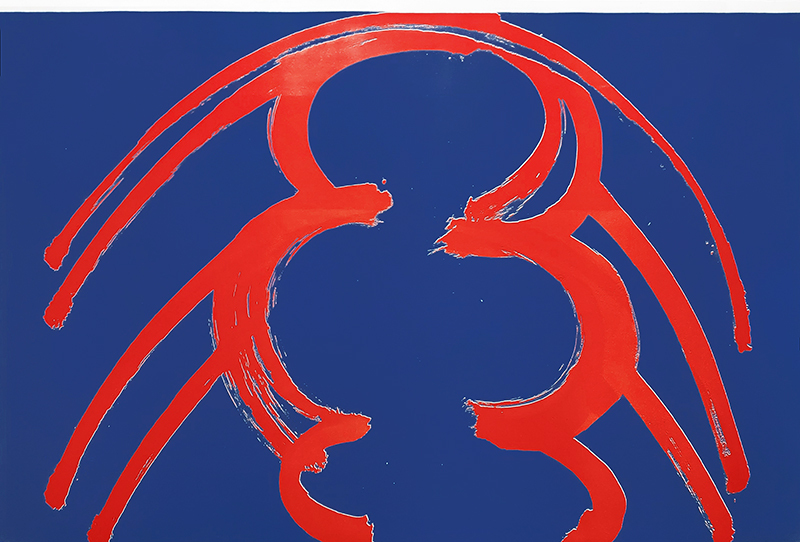
19th, 20th & 21st Century Fine Prints
707-546-7352 · fax 707-546-7924 · web: www.annexgalleries.com · email: artannex@aol.com
Easement by Mark di Suvero



Easement
Mark di Suvero
Easement
Mark di Suvero
1933 - PRESENT (biography)This lithograph is from the collection of Ransom and Nan Cook who owned property in Sonoma County, California near Penngrove and Petaluma. Sculptor Mark Di Suvero purchased adjoining property but had no easement to the road. The Cooks gave him the easement and he in turn created two large lithographs which he gave to them, titled "Easement". The other impression reverses the red and blue and the direction of the image, and is in the collection of the Fine Arts Museums of San Francisco, accession number 2008.65, donated by the Cooks. di Suvero's composition is bold and gestural with dramatic color. At the top is a thin 3/4 inch white space that extends from edge to edge - an "easement". The SF Museum impression is reversed, with the white easement border at the bottom.
Mark di Suvero was born Marco Polo di Suvero on September 19, 1933, in Tianjin, China, the son of a naval attaché for the Italian government. He would credit early exposure to the Forbidden City as instrumental to his aesthetic. His family emigrated to the United Stated with the onset of World War II, settling in San Francisco, California.
Di Suvero's formal education began at the City College of San Francisco (1953-'54) with a focus on philosophy, followed by the University of California at Santa Barbara (UCSB) (1954-'55), where his interest turned to sculpture. At UCSB he studied under Robert Thomas before transferring north to UC Berkeley, where he graduated with his degree in philosophy in 1957. Following graduation, he moved to New York City with friend and fellow sculptor Charles Ginnever to pursue a career in art. He joined the March Gallery artists' cooperative and supported himself through construction work, eventually using discarded site materials in his sculpture. He participated in his first exhibition at the March Gallery in January of 1959.
While on a job site in March of 1960, a near-fatal accident left him with a broken back and other severe spinal injuries, with doctors saying he would likely never walk again. This did not deter di Suvero, however, and after some months of drawing and painting, he learned arc welding, using a crane to position large pieces of wood and steel while seated in a cherry picker, wearing an iron apron on his lap as he constructed his pieces. He was given a solo show at the Green Gallery in November of that year, which opened to great critical acclaim. This experience, and the ensuing self-taught manipulation of industrial tools to carry out his vision, changed the path of di Suvero's work toward more monumental pieces, and would alter the world of American sculpting altogether. His determination did not end with his art: after five years of intensive physical therapy, he was able to walk again with the aid of leg braces and canes.
Throughout the 1960s he exhibited at the Park Place Gallery, a cooperative that he co-founded in 1962, and numerous other galleries throughout the U.S. Toward the end of the decade he began protesting the Vietnam war; after two arrests, he left the U.S. in self-exile, relocating to Europe where he exhibited in France, Germany, and the Netherlands. While living in Chalon-sur-Saone, France, he maintained a studio on a barge, the Rêve de signes, which later became an atelier for emerging artists and operated until 2002. He was the first living artist to be given a major exhibiton at Le Jardin des Tuileries in Paris, France, in 1975, as well as Les Esplanades des Invalides, Paris, and at Millenium Park, Chicago. He returned to the United States at the end of 1975, settling in Sonoma County, California, just north of San Francisco.
A seminal year in 1976 saw a major retrospective of his work at the Whitney Museum and the erection of several sculptures throughout the five boroughs of New York City, including 1966's Praise for Elohim Adonai in front of the Seagram Building in Midtown. In 1977 he co-founded the Athena Foundation to support emerging artists in all mediums, awarding the first grant to then-unknown composer Phillip Glass. Di Suvero purchased and converted an old riverfront warehouse in Long Island, New York, into a studio space called the Spacetime C.C. (Construct Corporation). In 1986 he founded Socrate's Sculpture Park, an outdoor museum and studio built on an old landfill site, which is still extant and focuses on up-and-coming sculptors and filmmakers, and hosting community programs.
Di Suvero continued to work and exhibit internationally through the 1990s and into the early 2000s. He was awarded the Lifetime Achievement Award in Contemporary Sculpture from the International SCulpture Center (2000); the Heinz Award for Arts and Humanities (2005); the Smithsonian Archives of American Art Medal (2010); and the American Academy of Arts and Letters Gold Medal for Sculpture (2013). In 2010 he was awarded a National Medal of the Arts by President Barack Obama.
In January of 2023 the first retrospective of his work in over 35 years opened at the Nasher Sculptural Center in Dallas, Texas, titled Mark di Suvero: Steel Like Paper. Notably, in addition to his sculpture, the show highlights several of his two-dimensional works, including paintings, drawings, and prints. Di Suvero continues to live and work in New York.



